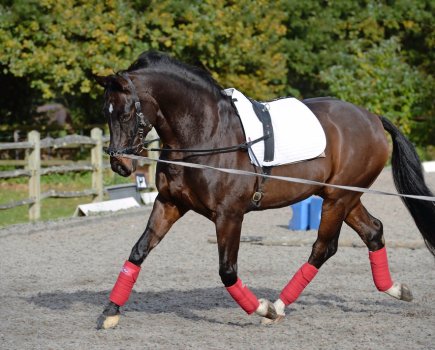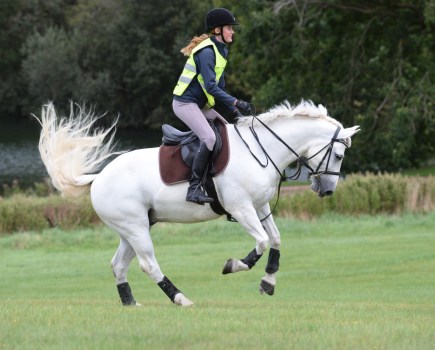A heavy breed of horse in the dressage arena? It might not be the norm, but a breed as large as a Clydesdale can show lightness, finesse and cadence.
Gharson, a 12-year-old gelding belonging to Nicola Read, is 18hh and weighs 900kg — and he competes at elementary level dressage.
“You wouldn’t expect such a heavy horse to have a natural aptitude for a discipline that requires lightness, impulsion, balance and cadence, but he has certain conformation traits that actually help him,” says Nicola.
Breaking down preconceptions
On the whole, dressage judges love Gharsun. However, Nicola has experienced negativity from other competitors.
“They usually say, ‘Oh look, somebody has brought a cart horse’ when they see him in the lorry park, before they see him strutting his stuff.
“Luckily I have thick skin and hearing comments like that fuel my determination to go out there and nail it. I enjoy proving people wrong and breaking down those preconceptions.”
Below, Nicola explains Gharson’s assets as a heavy horse breed and how she overcomes any drawbacks to his size in the dressage arena:
1 Body length
“Draught breeds tend to be shorter in the back, which helps them to sit up and carry themselves. Having a powerful back end also gives them that extra strength they need to lift and lighten the front end,” explains Nicola.
“They tend to be quite close behind, and in my experience, this gives them a huge advantage when it comes to lateral work.”
2 Paces
Nicola asks for a lot of shoulder-in when she is riding to encourage lift in front.
“Gharsun has a great over-track in walk and a naturally rhythmic trot. He always achieves good scores for all his paces,” she explains. “He is very light in the hand and pushes well from behind, so his collective marks are usually very good too — as long as my riding doesn’t let him down.”
3 Small circles
Suppleness in such a large horse requires time, patience and clever schooling.
“Suppleness is essential for coping with smaller circles and serpentines in novice tests,” says Nicola. “A horse of Gharsun’s size has considerably less room to move in a dressage arena compared to other horses, due to his overall size and length of stride.
“When we are competing, where some horses may have four strides between a quick succession of movements, Gharsun has only two. For smaller circles he not only finds the suppleness more difficult, but also balance and strength to cope with the tighter turn.”
4 Suppleness
“I start suppleness work by using shoulder-fore in our warm up as we ride across the diagonals,” explains Nicola.
“We then move into shoulder-in, and use leg-yield to increase and decrease the size of a circle. This involves changes of bend and counterflexion on the circle, which help with suppleness.
“I also incorporate pole work into our training; fanned poles on a circle or riding a circle over a square of poles builds flexibility and core strength.”
5 Transitions and length of stride
“He has a great walk to canter, which is eye-catching in such a big horse,” says Nicola.
“He used to struggle with lengthening his stride due to his breed type, as he had a tendency to lift his knees higher rather than extend the leg, so it took a while to teach him medium trot.
“I found that doing lots of pole work really helped teach him how to lengthen and shorten his stride, while also maintaining lift through the shoulder.”
6 Canter
Clydesdales typically don’t find canter easy, due to their build and the closeness of the back legs.
“This can cause them to tilt. It’s a little bit like a reverse trike, with one wheel at the back and two in front. I have to encourage Gharsun to part the back legs to improve his balance and engagement in canter.”
To address the issue, Nicola uses travers and walk pirouettes.
“Doing this followed by a quick canter transition helps with balance and, over time, strengthens the quality of the pace, enabling the horse to cope with corners and have better balance on a circle.”
7 Small spaces
The height and length of a heavy horse such as Gharsun makes working in a tight arena very hard work.
“Keep schooling sessions short and their frequency to a minimum,” advises Nicola. “I am mindful that because he is much bigger than your typical dressage horse, he will be far more prone to injury.
“It becomes even more important to listen to your horse and ease off if you feel they are starting to show signs of discomfort or struggling with the level of work.”
8 Hacking
Gharsun does lateral work when he’s hacking, making the most of long straight lines, which means his movements aren’t interrupted by regular corners. He also has more room to practise lengthening his stride and the change of scenery keeps him interested in his work. He schools in an arena twice a week.
“You will frequently find us cantering bareback round the fields in the summer too,” adds Nicola. “It works on my core strength and Gharsun seems to find it more fun without a saddle.”
9 ‘Not just a cart horse’
Nicola says the challenges posed by Gharsun’s size have been the most rewarding in the end.
“I don’t think these horses should be dismissed as ‘just a cart horse’, which I do hear people say,” she adds.
“Clydesdales have the physical and mental ability to compete in many spheres, you just need to be prepared to take extra time in the training process and allow much longer for them to grow and develop, to reduce the risk of injury.
“I have really enjoyed the process of training in a different way and thinking outside the box. I wouldn’t go back to riding a finer breed now.”
Main photo by Lottie Elizabeth Photography; copyright Your Horse Library/Kelsey Media









